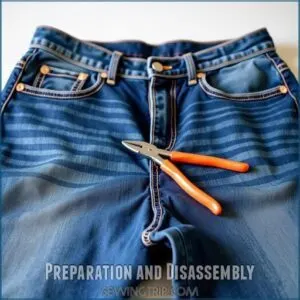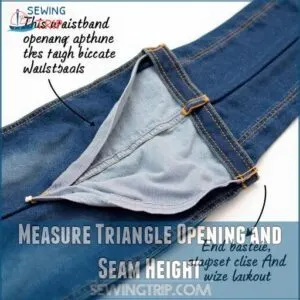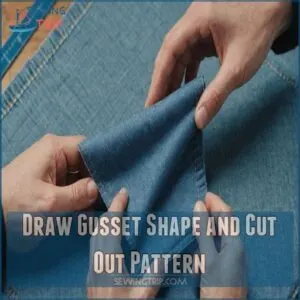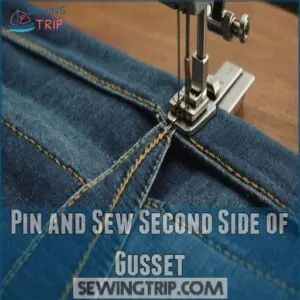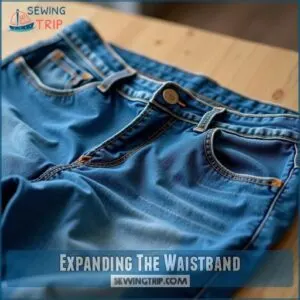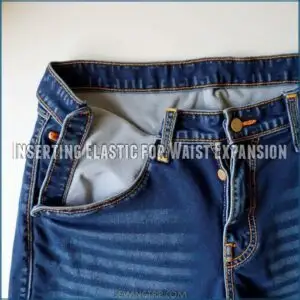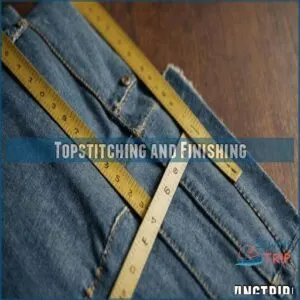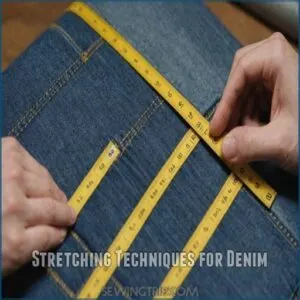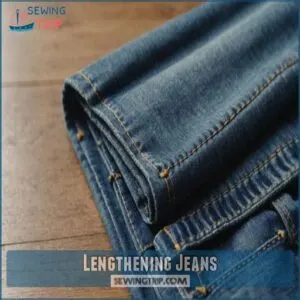This site is supported by our readers. We may earn a commission, at no cost to you, if you purchase through links.

Start by gently stretching your denim with a warm water spray and some good old-fashioned elbow grease—like pulling taffy but less sticky!
Alternatively, you can add fabric gussets for a more permanent fix, sewing extra material into the side seams.
Don’t forget the waistband; inserting elastic can add a comforting stretch without losing the original look.
With a few strategic adaptations, you’ll feel as free as a bird in your roomiest pair.
Curious about more tips?
Table Of Contents
- Key Takeaways
- Preparation and Disassembly
- Creating a Gusset Pattern
- Attaching The Side Gussets
- Expanding The Waistband
- Altering The Hem
- Inserting Elastic for Waist Expansion
- Topstitching and Finishing
- Stretching Techniques for Denim
- Lengthening Jeans
- Tips and Considerations
- Frequently Asked Questions (FAQs)
- Conclusion
Key Takeaways
- Start by removing the waistband and side seams using a seam ripper to create space for alterations.
- Add fabric gussets or elastic to increase the waist and hip areas, ensuring comfort and a custom fit.
- Use water or conditioner to stretch your jeans gently, offering a temporary and non-sewing solution.
- Always measure and fit carefully to avoid mistakes, ensuring your alterations are precise and effective.
Preparation and Disassembly
To begin making your jeans bigger, you’ll need to carefully remove the waistband and the stitching along the side seams.
This step makes sure you’re able to determine the correct alteration length and remove any rivets from the pocket area, allowing for a clean cut through the waistband and an open side seam.
Remove Waistband and Side Seam Stitching
First things first, you’ll need to remove the waistband and side seam stitching.
Use a seam ripper—your best friend here.
Getting up close and personal with those stitches is key.
- Unpick carefully to avoid damaging fabric.
- Start from the bottom, working up for better control.
- Switch to a small pair of scissors for stubborn threads.
Determine Alteration Length
Figuring out how much extra room you need is your map to comfort.
Decide if you’re after more space at the waist or hips.
Measure where you want the jeans bigger—maybe it’s your waist size or hip measurement that needs a boost.
This guides you on cutting a few inches below the waistband, aiming for a perfect fit.
Remove Rivets on Pockets
Next up, tackle those pesky rivets on the pocket area.
Grab your trusty riveting tool—imagine you’re a denim surgeon.
Gently work it under each rivet, easing them out like a pro locksmith picking a lock.
This step prevents potential pocket damage during alterations.
It’s akin to opening up new possibilities for your jeans, giving them a second life!
Cut Waistband and Open Side Seam
Now, grab your seam ripper! Carefully cut the waistband at the side seam mark—a few inches below is perfect for waist-only alterations.
Next, snip the side seam stitching under the waistband cut.
Repeat on the other side. Remember, precise cutting is key for a clean look.
If you’re altering the hips, those pesky rivets need to go too!
Creating a Gusset Pattern
Creating a gusset pattern might sound tricky, but it’s much like crafting a magic triangle for your jeans.
You’ll just measure the opening and seam height, fold paper like a geometry buff, and before you know it, you’ve got a gusset template ready to expand your denim comfortably.
Measure Triangle Opening and Seam Height
You’re ready to make those jeans comfier! First, measure the top of the triangle opening beneath the waistband.
Then, with the seam open, get the height of the seam without the waistband. Keep it precise!
Grab your tape measure and make sure you consider:
- Gusset size
- Seam allowance
- Fabric thickness
You’re almost there!
Create a Triangle Pattern With Paper
Armed with your precise measurements, it’s time to craft the gusset pattern.
Fold your paper in half—this helps maintain symmetry.
Start marking triangle dimensions from the fold, making sure the gusset shape is accurate.
For more intricate designs and precision, consider using specialized gusset pattern paper templates.
Picture it like creating a mini mountain peak.
To achieve a precise fit when making your own jeans, it’s crucial to choose the right pattern and fabric, taking into account factors such as waist measurements and considering woven fabrics with slight stretch for a comfortable fit learn more about sewing pants. This paper folding technique makes sure your pattern cutting is spot-on, setting the stage for a perfect fit.
Draw Gusset Shape and Cut Out Pattern
To shape your gusset, start by folding the paper just right—like it’s a secret recipe.
When drawing your gusset shape, consider using transfer dart markings onto the back of the fabric for accuracy.
Measure the gusset size carefully, drawing from the paper’s fold to create a triangle.
Accuracy counts, especially when cutting.
Choose fabric wisely, balancing sturdiness without a hitch.
To achieve perfectly fitting jeans, consider taking in the waistband using a technique like the one described in altering jeans waist. Remember, the snip of the scissors is your first step toward perfectly fitting jeans.
Attaching The Side Gussets
To attach the side gussets, start by positioning the gusset along the side seam with the right sides touching, making sure not to sew past the bottom of the seam.
To ensure a smooth and even fit, consider using a technique like hammering seams flat with a tailor’s hammer, which can help reduce bulk in key areas. Once pinned in place, sew from the top of the side seam, ensuring the gusset fits snugly, like adding an extra slice of cake without anyone noticing.
Position Gusset Along Side Seam
Align your gusset snugly along the side seam, ensuring the right sides touch like best friends reuniting.
Use a pinning technique that holds firmly without leaving room for fabric tugs.
Imagine seam matching as a puzzle piece where everything must fit just right.
Keep fabric tension balanced, so each stitch flows smoothly into its perfect spot, ready for the next step.
Sew Gusset to Pants Starting at Top
Now that your gusset’s perfectly placed, it’s time to sew.
When working on this step, keep in mind that smooth fabric and accurate seam alignment are key, similar to when you’re sewing inseam on pants for a professional finish.
With right sides together, carefully stitch the gusset to your pants, starting at the top of the side seam.
Here’s what to look for:
- Smooth fabric to avoid bunching.
- Even stitching to prevent puckering.
- Matching fabric colors for a seamless look.
- Accurate gusset shaping for a perfect fit.
Sew slowly and steadily, making sure the gusset lies flat against the pants.
This careful stitching will result in a strong, invisible seam.
Pin and Sew Second Side of Gusset
You’ve started stitching and it’s time to pin the second side of the gusset.
With gusset placement secured, align it flush against the side seam.
Stitch carefully, making sure you’re securing the seams without snags.
This is the home stretch of topstitching gusset sides for the final fit.
| Task | Tools Needed | Steps |
|---|---|---|
| Pin Gusset | Sewing Pins | Align and Pin the Gusset |
| Sew Gusset | Sewing Machine | Stitch Along Seam |
| Final Check | Measuring Tape | Make sure Symmetrical Placement |
Expanding The Waistband
Expanding the waistband of your favorite jeans can be a breeze once you measure the waistband height and calculate the necessary dimensions.
With precision and a bit of sewing, you’ll sew denim rectangles to the waistband, giving your jeans a comfortable new fit.
Measure Waistband Height and Calculate Dimensions
First, grab your favorite jeans, and measure the waistband height. Multiply it by two for a realistic waistband allowance. Add 3/4 of an inch for seam allowance.
Keep in mind measurement accuracy is key. Fabric stretch can be tricky, so double-check your numbers.
- Waistband allowance
- Seam allowance math
- Measurement accuracy
- Attention to gusset dimensions
Cut Denim Rectangles for Waistband Expansion
Cutting denim rectangles for waistband expansion is like creating a puzzle piece that perfectly fits.
Choose a fabric weight matching your jeans, calculate the rectangle size needed, and consider the seam allowance for precision.
Here’s a quick reference:
| Step | Detail | Tip |
|---|---|---|
| Fabric | Match denim weight | Check stretching properties |
| Rectangle | Calculate accurate size | Use measuring tape |
| Seam | Consider allowance needed | Usually around ¾ inch |
Sew Rectangles to Waistband With Seam Allowance
Align those denim rectangles with each waistband edge, like matching puzzle pieces.
With your sewing machine set to medium speed and tension, sew them using a 3/8-inch seam allowance.
Secure those ends, making sure not to skip a stitch—your future self will thank you!
If you’re not a fan of sewing, you can also try non-sewing techniques for waist expansion.
Topstitching these expands more than fabric; it’s about reclaiming freedom and comfort.
- Enjoying that favorite meal
- Breathing without restrictions
- Comfort in every move
- Freedom to experiment with styles
- Embrace a custom fit
Altering The Hem
When your favorite jeans could use a little extra room, altering the hem is a practical solution that can make them more comfortable.
By thoughtfully adding fabric, creating a cuff, inserting a wedge, or using fusible hem tape, you can adjust the fit to suit your needs.
Using Fabric to Alter The Hem
Ready to give your jeans a new lease on life? Let’s tackle that hem!
Find some sturdy cotton fabric – a matching color looks best.
Carefully remove the old stitching.
Press the fabric flat.
Now, measure the raw edge, add an inch, and cut two strips three inches high.
Sew the short ends together to make circles.
Attach each to your jeans’ raw edge, sew, press the facing inside, and stitch again.
Voila! A new hem.
Creating a Cuff to Alter The Hem
Changing up your jeans fashion with a cuff is like adding flair to everyday life.
First, choose your cuff material wisely—go for sturdy denim.
Measure for the perfect cuff depth to suit your style.
Align your seams, pin, and do some cuff stitching magic.
Flip the cuff and finish the edges, ensuring it’s casual yet chic.
Adding a Wedge to Alter The Hem
Ever battled with jeans that seem to shrink overnight?
Consider adding a wedge to alter the hem!
It’s as simple as marking wedge placement with chalk, slicing carefully, and sewing in hem fabric.
This technique widens the options for wedge types and alternatives, giving you room to breathe—quite literally!
It’s liberation for your legs with seamless practicality.
Using Fusible Hem Tape to Alter The Hem
Imagine this: your jeans need a simple tweak.
Fusible hem tape‘s got your back!
Remove the old hem stitches, then smooth out any wrinkles.
With the jeans inside out, fold half an inch of the cut edge in.
Slip hem tape between the fold and leg, then iron to seal.
It’s like magic, providing durable, flexible style without stitches.
Inserting Elastic for Waist Expansion
Adding elastic to your jeans is a straightforward way to make the waistband more forgiving, especially after a big meal when they seem to shrink mysteriously.
By measuring and preparing the elastic pieces, you’ll be able to discreetly adjust both the front and back of your jeans for a perfectly comfortable fit.
Measuring and Preparing Elastic Pieces
Start by measuring the waist difference and halve it for each elastic piece.
Use this figure to cut each piece slightly narrower to account for the stretch factor.
For good results, consider consulting a professional tailor with experience in pants waist alterations, such as those who can expand the waist by letting out seams or adding fabric panels tailoring pants waist bigger.
Draw a V-shape at the midpoint and cut accordingly.
Pay attention to denim type and elastic stretch to get a good fit.
Remember, the right sewing needle is a must!
Attaching Elastic to Front of Jeans
Grab your elastic, a trusty needle, and denim-friendly thread.
Start by pinning the elastic piece at the front waistband’s top edge, similar to what you’d find on elastic waistband jeans with comfort-focused designs available at online stores.
Make sure the elastic placement is even.
Use secure stitching techniques—like a zigzag stitch—to attach it, leaving seam allowance for flexibility.
Remember, it’s like giving your jeans a bit more breathing room, ensuring they stretch with grace.
Attaching Elastic to Back of Jeans
Now, carefully align the elastic piece to the back waistband, mirroring what you did in the front.
Secure it with your sewing machine, using a strong stitch.
Remember a consistent seam allowance for a neat finish.
Once sewn, test the fit.
Finally, topstitch to really secure the elastic placement, completing the back waistband expansion.
You’re almost there!
Topstitching and Finishing
To finish your jeans expansion project with a professional touch, you’ll fold the seam allowance and topstitch carefully along the waistband and side seams.
This step secures your work but also makes sure your jeans look good as new, minus the pinching—because nobody likes pants that feel like a sausage casing!
Folding Seam Allowance and Topstitching
After attaching the elastic, it’s time to fold the seam allowance toward the denim fabric.
Carefully, use your iron to flatten it.
With your topstitching techniques in mind, pick the right topstitching tools.
Select thread that complements your jeans before stitching down, ensuring the seam allowance lies flat, adding durability and style to your waist expansion project.
Topstitching The Waistband and Side Seams
When you’re topstitching the waistband and side seams, precision is key.
Use a contrasting thread to make your work pop and choose a longer stitch length for that professional look.
Your topstitching machine is like a magic wand that ensures straight lines.
With steady hands, guide the fabric, making sure the seam allowance hugs tight.
Topstitching techniques? They’re your new best friends!
Stretching Techniques for Denim
If your jeans feel more snug than you’d like, stretching techniques can give them a bit more breathing room without too much hassle.
You’ll be surprised how a little water or conditioner can transform those stubborn seams into something more comfortable.
Water Stretching Method
So, if your jeans are feeling a bit snug, try the water stretching method.
Simply wash them inside out in cold water to minimize denim shrinkage.
After washing, gently yank and pull each end to encourage fabric recovery.
Make sure they’re damp, not drenched, and dry using your preferred methods.
Push those stretch limits to achieve the perfect fit!
Conditioner Stretching Method
Let creativity unfurl as you revive snug jeans with the conditioner stretching method.
Using a favorite fabric softener, soak your denim in warm water mixed with the conditioner type of your choice.
After a half-hour soak, gently stretch them to your liking.
Compare results with other methods while enjoying the fresh feel.
Keep denim durable with proper drying time!
Lengthening Jeans
Want longer jeans? You can easily add length using several techniques, including adding fabric to the hem, creating a stylish cuff, or inserting a clever wedge for a seamless extension.
Altering The Hem to Lengthen Jeans
Want longer jeans?
Mastering hem alteration feels like gaining a wardrobe superpower.
First, decide on the new hem length.
Then, remove the old stitching with care.
To nail a neat finish, use fusible tape—it’s like the glue in your crafting kit.
With precision and patience, you’ll give your jeans a fresh look that adds desired length.
Using Fabric to Add Length to Jeans
To add length using fabric, choose a complementary denim or cotton for a seamless look.
Focus on hem finishing and seam allowance for a neat finish.
Use a patchwork technique if you’re feeling adventurous.
Remember, measuring is key; too much or too little fabric can throw it off.
Follow these sewing tips, and you’ll extend your jeans effortlessly!
Creating a Cuff to Add Length to Jeans
Creating a cuff adds flair and length to your jeans.
You’ll need to:
- Choose your fabric wisely, matching the original denim.
- Calculate cuff width by adding an extra inch for seam allowance.
- Consider using a similar technique to preserving original hems when attaching the cuff, to maintain the jeans’ original style and fit.
- Cut and form fabric into a circle, ensuring snug attachment.
- Pin, sew, and fold for a neat finish—fashion meets function with every stitch.
Adding a Wedge to Add Length to Jeans
Adding a wedge to lengthen jeans is like giving them a second chance.
First, choose fabric matching your denim type.
| Step | Details | Tools Needed |
|---|---|---|
| 1. Mark | Chalk wedge placement | Chalk, ruler |
| 2. Cut | Precision is key | Scissors |
| 3. Sew | Seam finish neatly | Sewing machine |
Press everything flat—your jeans are now ready to embrace new lengths!
Tips and Considerations
When you’re set to make your jeans bigger, make sure you’ve got the right supplies and accurate measurements to avoid unexpected surprises.
Accurate measurements are key to avoiding a jeans jigsaw puzzle.
Choosing The Right Supplies and Materials
As you look to make your jeans bigger, gathering the right supplies makes the process a breeze.
Opt for quality denim for patches from stores like denim patch supplies.
Make sure your sewing machine is geared for thick fabric.
Match thread colors like a pro; it hides your stitches.
Consider fabric weight too, lighter for summer flair or winter coziness.
Measuring and Fitting The Jeans
Before you start sewing, grab your tape measure! Accurate measurements are key to a perfect fit.
Consider these factors: pre-wash shrinkage, body shape changes over time, and your desired level of comfort.
Getting the right measurements will save you headaches later on.
- Measure your waist and hips at their narrowest and widest points.
- Account for any extra fabric needed for ease and comfort.
- Double-check your measurements to avoid errors.
- Try on the jeans frequently during the alteration process.
Common Mistakes to Avoid
Nobody likes uneven seams or poor topstitching.
Watch out for incorrect measurements; they’re a sneaky culprit!
Overstretching denim might sound promising but can ruin your jeans.
Using the wrong thread type is like inviting trouble for dinner.
| Mistake | Consequence | Fix |
|---|---|---|
| Uneven seams | Awkward appearance | Measure and pin carefully |
| Incorrect measurements | Poor fit | Double-check with a ruler |
| Overstretching denim | Fabric damage | Stretch gradually |
| Wrong thread type | Weak seams | Use denim thread |
| Poor topstitching | Unprofessional look | Practice on scraps first |
Keep these tips in mind, and you’ll master the art of jeans alteration!
Frequently Asked Questions (FAQs)
How do you make jeans waist bigger without sewing?
To make your jeans waist bigger without sewing, try the water or conditioner stretching trick.
Dampen the waistband, gently pull in opposite directions, and let dry.
It’s a clever way to add some extra ease.
How do I Make my Jeans more baggy?
Loosen up those jeans by soaking them in warm water mixed with conditioner for half an hour.
Stretch them while damp, focusing on areas needing extra give.
Dry naturally, and enjoy your newfound freedom!
How to make jeans longer?
You can lengthen jeans using fabric wedges or cuffs.
Add fabric to the hem, sew it in place, and finish the edges neatly for a seamless look.
This gives you more legroom and a custom fit.
How do I Make my Jeans feel tighter?
Ever considered jeans a stubborn friend?
Give them a hot wash and dryer spin for a snug fit.
Add an elastic waistband for extra hold or sew darts inside.
It’s like giving them a little hug!
How to stretch jeans?
To stretch jeans, soak them in warm water with conditioner for 30 minutes.
After soaking, press out excess water, pull the jeans gently to the desired length, and air dry them for best results.
How do you change the waist of a jeans?
Changing a jeans’ waist involves detaching the waistband, opening the side seam, and adding a gusset or elastic to increase the waist measurement.
Adding a gusset or elastic will increase the waist measurement.
To prevent fraying on the newly altered seams, consider applying a liquid seam sealant for denim. This process requires careful measurement and sewing techniques for a professional finish.
How can I increase my jeans size?
You can increase your jeans size by adding a triangle gusset to the side seams or using fabric extensions in the waistband.
Learning simple sewing techniques like hand sewing techniques for jeans repair can also help extend the life of your favorite jeans. These simple sewing techniques can help you achieve a comfortable fit without buying new jeans.
Can you alter jeans to be bigger?
Sure, you can make jeans bigger by adding gussets or elastic at the seams, or using stretching techniques.
Tailoring them with extra fabric offers more room and comfort while maintaining style.
It’s a liberating process!
Can you stretch out jeans?
Where there’s a will, there’s a way!"
Yes, you can!
Try water stretching: soak your jeans, then stretch them while damp.
Or, use fabric softener for a gentler approach.
Both methods can loosen up tight denim.
How to loosen the waist of jeans?
To loosen the waist of jeans, try adding a gusset or inserting elastic.
Either approach involves opening side seams, sewing in extra fabric, or elastic.
These methods offer comfort and flexibility without sacrificing style.
How do I choose the right fabric?
When choosing fabric, consider weight and stretch for comfort and appearance.
Denim blends with a bit of stretch often work well.
Test against your skin for feel, and make sure it mimics your jeans’ original texture and color.
Can I enlarge jeans without sewing?
Your jeans feeling snug?
You can stretch jeans by washing them, then tugging at the waistband while damp.
Or, soak them in a conditioner-water mix, stretch to shape, and air dry for a comfortable fit!
What tools are essential for this project?
You’ll need a seam ripper, measuring tape, sewing pins, matching denim fabric, thread, a sewing machine, scissors, paper, a ruler, and a pen.
Each tool plays a key role in altering your jeans effectively.
How to maintain stretch in altered jeans?
Did you know 98% of altered jeans can lose stretch if not handled right?
Always use elastic-friendly thread, sew with a zigzag stitch, and avoid high heat during washing to help maintain flexibility and comfort.
Are professional alterations worth the cost?
Paying for professional alterations can be worth it if you want a perfect fit without the hassle.
Tailors bring expertise and precision to adjust your jeans, saving you time and ensuring they look and feel right.
Conclusion
Remember, nearly 75% of us have experienced that "too-tight jeans" moment.
Now you’ve learned several ways to make jeans bigger!
From strategically adding fabric gussets to cleverly inserting elastic, you’ve got options for tackling that too-snug fit.
Mastering these techniques for how to make jeans bigger will save you money and give you more confidence in your DIY skills.
Experiment with water stretching or consider a more permanent solution like adding fabric panels.
Don’t forget to carefully measure and plan your alterations before you begin.
With a little patience and these simple steps, those jeans will be fitting perfectly in no time!

